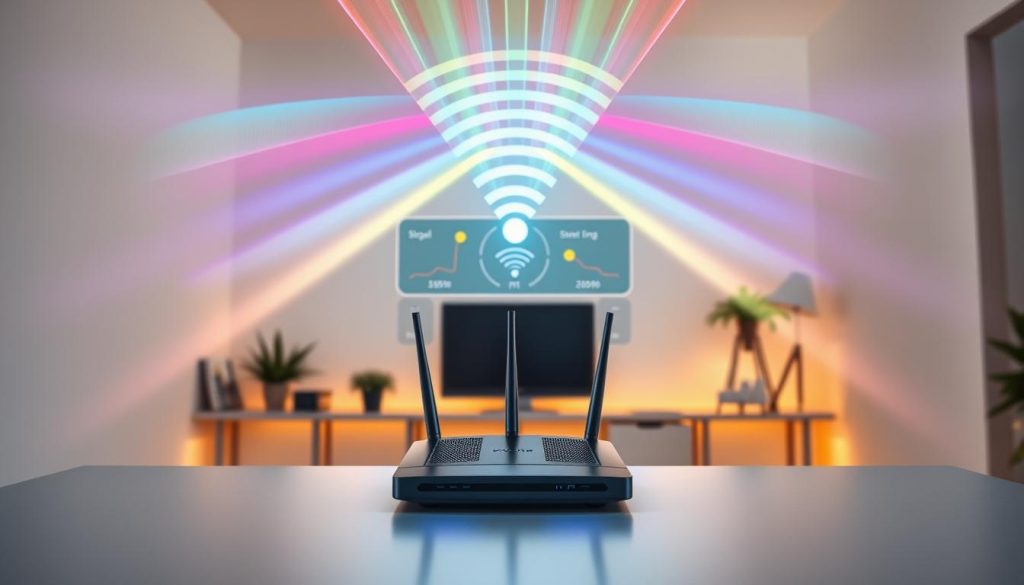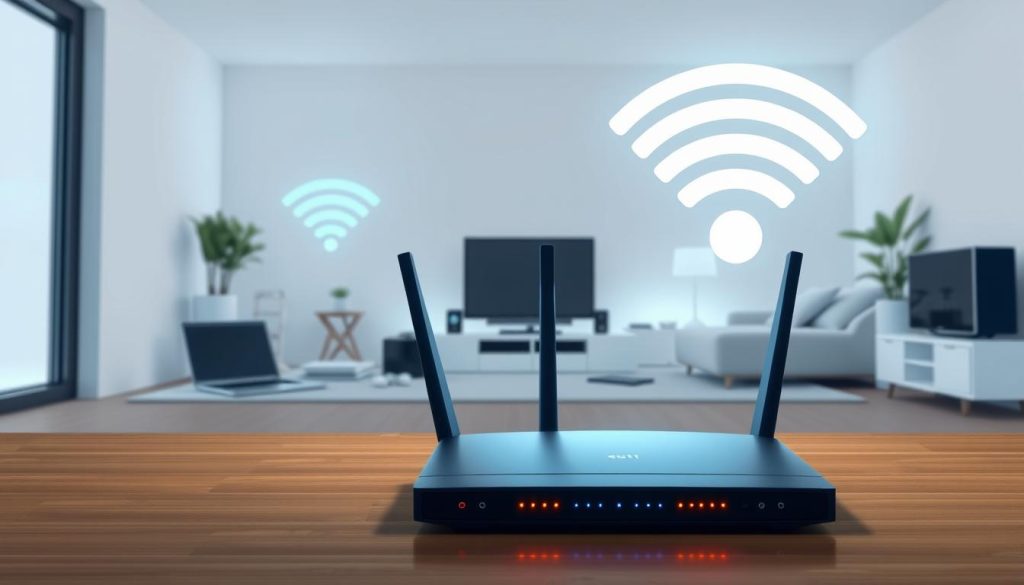Many are curious about the secret to seamless iptv wifi optimization and strong wifi signal for uninterrupted streaming. With so many devices and services, like iptv subscription providers, it’s key to know how to optimize iptv for your home network1.
Optimizing iptv streaming means understanding the tech and infrastructure behind it. This includes how network congestion affects performance and the benefits of adaptive bitrate streaming. A stable internet connection with enough bandwidth is also crucial for quality streaming1.
By learning about these aspects and setting up your router correctly, you can greatly improve your iptv streaming. This includes choosing the right channels, setting up qos, and optimizing dns2.
Table of Contents
ToggleKey Takeaways
- Knowing the minimum speed needed for streaming, like 0.5 Megabits per second, and the recommended speed for iptv, 1.5 Megabits per second, is key for optimizing streaming3.
- Setting up qos and dns optimization can greatly improve iptv performance and cut down on buffering2.
- Using a wired ethernet connection can give more consistent speeds than wifi, leading to better streaming quality1.
- Regularly checking your network’s performance is vital to find and fix issues affecting iptv delivery and optimize wifi optimization2.
- Placing your router strategically and using wifi extenders or powerline adapters can boost wifi signal and coverage3.
- Switching servers during peak hours can help reduce congestion and improve streaming performance1.
- Premium iptv services often offer better quality and reliability, leading to a better viewing experience1.
Understanding IPTV Streaming Requirements
To enjoy IPTV without interruptions, knowing the bandwidth needs is key. For HD, you need at least 25 Mbps, and for 4K, it’s 50 Mbps4. This ensures you avoid iptv buffering solution problems. Also, a steady internet connection is crucial for keeping video quality high, making wifi network optimization very important.
A wifi speed test can show if your internet is up to IPTV streaming. Knowing how quality and bandwidth relate helps you choose the right internet plan and iptv wifi optimization needs. The global IPTV market size was about USD 49.41 billion in 2020 and is growing fast5.
Network stability is key for streaming quality, and wifi network optimization helps a lot. By focusing on video packet delivery, you can lower latency and improve the quality of experience (QoE)6. This is very important for live TV streaming, where fast and consistent performance is needed. With the right iptv wifi optimization strategies, you can have a smooth and high-quality IPTV streaming experience.
Assessing Your Current WiFi Network Performance
To make your WiFi better for IPTV and IPTV network optimization, you need to check how it’s doing. Look at your network’s bandwidth, throughput, and how well it works. Bandwidth is how fast data can move, and throughput is how much data actually moves7. A good Content Delivery Network (CDN) helps keep your network fast, even when lots of people are using it7.
When checking your WiFi, think about how much bandwidth you need for IPTV. For example, SD IPTV needs 3–5 Mbps, and HD IPTV needs 5–10 Mbps8. Use WiFi analyzers to find ways to make your network better.
Also, think about how network congestion affects your IPTV. When many devices use the same bandwidth, it can slow down your stream8. To fix this, use routers that support dual-band or tri-band Wi-Fi. They offer faster speeds and better connection8. By checking your WiFi and making changes, you can make your network better for IPTV and stream without problems.
Remember, half of all network trouble calls are about WiFi9. Use tools like the WiFi Advisor to see how your network is doing. The WiFi Advisor works well for different devices and supports both 2.4 GHz and 5 GHz bands9. By checking and improving your WiFi, you can have a great IPTV experience and enjoy IPTV optimization.
Essential Router Settings for IPTV WiFi Optimization
To get the best out of IPTV streaming over WiFi, setting up your router right is key. You need to pick the best channel and set up Quality of Service (QoS) to make sure IPTV gets priority10. This ensures your streaming is smooth and without breaks. The best solutions often mix these settings, based on your IPTV service and router.
Choosing the right channel is important to avoid interference from other devices11. Use a WiFi analyzer to find the least busy channel. Also, setting up QoS rules helps make sure IPTV gets more bandwidth than other internet uses10. This means IPTV gets a steady amount of bandwidth, even when others are using the internet.
By following these steps and adjusting your router settings, you can make your IPTV streaming better. You’ll get high-quality video and audio over WiFi10. Remember, the exact settings might change based on your router and IPTV service. Always check your user manual or contact your service provider for help.
Strategic Router Placement for Maximum Coverage

Also, putting the router up can help reach more devices. This is very helpful in rooms with low ceilings13.
When setting up your router, think about what’s around it. Thick walls, big furniture, and water can block Wi-Fi signals13. Keeping devices away from the router can also help avoid signal loss13. This way, you can make your iptv device connectivity optimization better and enjoy smoother iptv playback smoothness.
Troubleshooting Common IPTV Streaming Issues
When you face IPTV streaming problems, finding the main cause is key. To fix it, start by checking your internet speed. You need at least 12 Mbps for smooth streaming15. Also, a stable internet connection helps avoid buffering. Using a wired Ethernet connection can make your internet more stable, cutting down on buffering15.
For better picture quality, try lowering the streaming resolution. Switching from 4K or 8K to 720p or 1080p can help. This reduces the demand on your internet and device15. A good VPN can also boost your streaming. High-performance VPNs like ExpressVPN, NordVPN, and CyberGhost are recommended for the best speeds15. Changing to a less busy VPN server can also help avoid connection drops, making your stream smoother15.
Regularly updating your IPTV app and firmware is also important. Outdated versions can cause problems like frozen screens16. About 30% of users face frozen screens because of old firmware or app versions16. Keeping your app and firmware up to date can prevent these issues. This way, you can enjoy smooth IPTV streaming with better signal quality16.
Remember, reaching out to customer support can also help solve technical problems. Many IPTV providers encourage direct communication15. By following these tips and keeping your internet stable, you can reduce troubleshooting and enjoy top-notch IPTV streaming.
Advanced WiFi Network Configuration Tips

By following these advanced tips, you can make your IPTV streaming much better. Remember, the type of Wi-Fi band you use can affect your streaming quality18. So, pick the right band and set up your router to get the best wifi network boosting and iptv networking solutions.
Hardware Upgrades to Enhance IPTV Performance
For the best iptv optimization, upgrading your hardware is key. This boosts your streaming, even in big homes or where many devices fight for bandwidth. Data shows20 you need at least 25 Mbps for HD streaming and 50 Mbps for 4K.
Mesh networks are great for wifi optimization. They ensure a strong connection everywhere in your home. They’re perfect for homes with weak spots21. WiFi extenders or Powerline adapters can also help, but mesh systems are more seamless.
The latest routers, like Wi-Fi 6, are crucial for network optimization. They handle many devices and high-bandwidth tasks like streaming well. Keeping your router’s firmware updated and using QoS settings can also improve streaming quality22.
Choosing the right hardware upgrade depends on your home’s needs. By understanding iptv optimization, wifi optimization, and network optimization, you can pick the best options. This way, you can enjoy smooth, uninterrupted streaming.
Network Security Measures for Safe IPTV Streaming

Securing your WiFi with a firewall and updating your router’s software is also key. This helps fight off cyber threats and keeps your iptv security strong24.
By focusing on network security, wifi security, and iptv security, you can make sure your users have a great streaming experience23.
Optimizing Multiple Device Connections
To enhance iptv viewing experience, it’s key to manage multiple devices well. This means controlling bandwidth and setting priorities for devices. This ensures IPTV streams smoothly. For example, SD streaming needs at least 3 Mbps, while HD streaming needs 5-10 Mbps26.
Setting up your network with these speeds in mind is crucial. This makes sure your IPTV works well.
Another important step is to prioritize devices. Make sure devices that need lots of bandwidth, like IPTV, get priority. Using Quality of Service (QoS) settings on routers helps manage this. It’s great for homes with many devices online at once27.
Choosing a router that supports both 2.4 GHz and 5 GHz frequencies is also smart. This boosts your IPTV’s performance.
Bandwidth Management
Managing bandwidth well is essential for handling many devices. Keep an eye on your internet speed and tweak settings as needed. This ensures all devices get enough bandwidth.
Also, updating IPTV apps regularly can improve performance. This makes your streaming better and less likely to be interrupted27.
By following these tips and using the data provided, you can make your IPTV better. Always check your network and adjust settings to keep your IPTV streaming smooth26.
Conclusion: Achieving the Perfect IPTV Streaming Experience
To get the best IPTV streaming, you need to do a few things. First, make sure your WiFi is top-notch. Then, use the right equipment and follow some key tips. This way, you’ll get a smooth and engaging viewing experience.
IPTV has changed how we watch TV, making it cheaper and more flexible. It lets you stream shows from over 200 countries. This means you can find lots of international content that interests you.
For the best IPTV, you need a fast and reliable internet. You should have at least 5 Mbps for HD streaming. Improve your WiFi by setting up your router right and using the latest tech. This helps avoid problems like buffering or poor picture quality.
Also, IPTV now works with smart home tech. This lets you control your TV from home. As IPTV grows, with a value of over $100 billion by 2030, staying up-to-date is important for a great streaming experience.
Whether you’re tech-savvy or just want better home entertainment, this article has you covered. By using the right gear, software, and network setup, you can dive into high-quality, on-demand content. Enjoy the best IPTV streaming experience possible.
FAQ
What are the minimum bandwidth requirements for IPTV streaming?
The bandwidth needed for IPTV streaming varies with video quality. SD IPTV streams need 3-5 Mbps. HD streams require 5-10 Mbps. UHD streams might need 15-25 Mbps or more.
How does network stability impact IPTV streaming quality?
Network stability is key for IPTV streaming. Speed changes, packet loss, and latency can cause buffering and video issues. A stable WiFi network is crucial for smooth streaming.
How can I assess my current WiFi network performance for IPTV streaming?
Use WiFi speed tests and analyzers to check your network. These tools show signal strength and network issues that affect IPTV quality.
What are the essential router settings for IPTV WiFi optimization?
Important router settings include:- Choosing the right WiFi channel and width to reduce interference- Setting Quality of Service (QoS) for IPTV traffic- Optimizing DNS for faster content resolution- Configuring DHCP for better IP address assignment
How should I strategically place my router to improve IPTV streaming coverage?
Place your router centrally, away from obstacles and interference. Avoid thick walls, metal, and other wireless devices to improve signal.
How can I troubleshoot common IPTV streaming issues, such as buffering and picture quality problems?
To fix IPTV issues, check your internet speed and network stability. Ensure your router is set for IPTV streaming. Fix WiFi signal problems and update your IPTV device.
What advanced WiFi network configuration tips can I use to improve IPTV streaming quality?
Advanced tips include:- Setting Quality of Service (QoS) for IPTV- Using network segmentation for IPTV devices- Enabling features like beamforming and MU-MIMO for better coverage
What hardware upgrades can I consider to enhance IPTV performance?
Consider upgrades like mesh networks for seamless coverage. WiFi extenders or powerline adapters can also help. The latest router technology, like WiFi 6, offers faster performance.
How can I ensure network security for safe IPTV streaming?
For secure IPTV streaming, use strong passwords and WPA2 or WPA3 encryption. Update your router’s firmware regularly. A VPN adds extra security.
How can I optimize multiple device connections for IPTV streaming?
To manage multiple devices, manage bandwidth and prioritize IPTV traffic. Isolate IPTV devices with network segmentation. This ensures they get the needed bandwidth.


